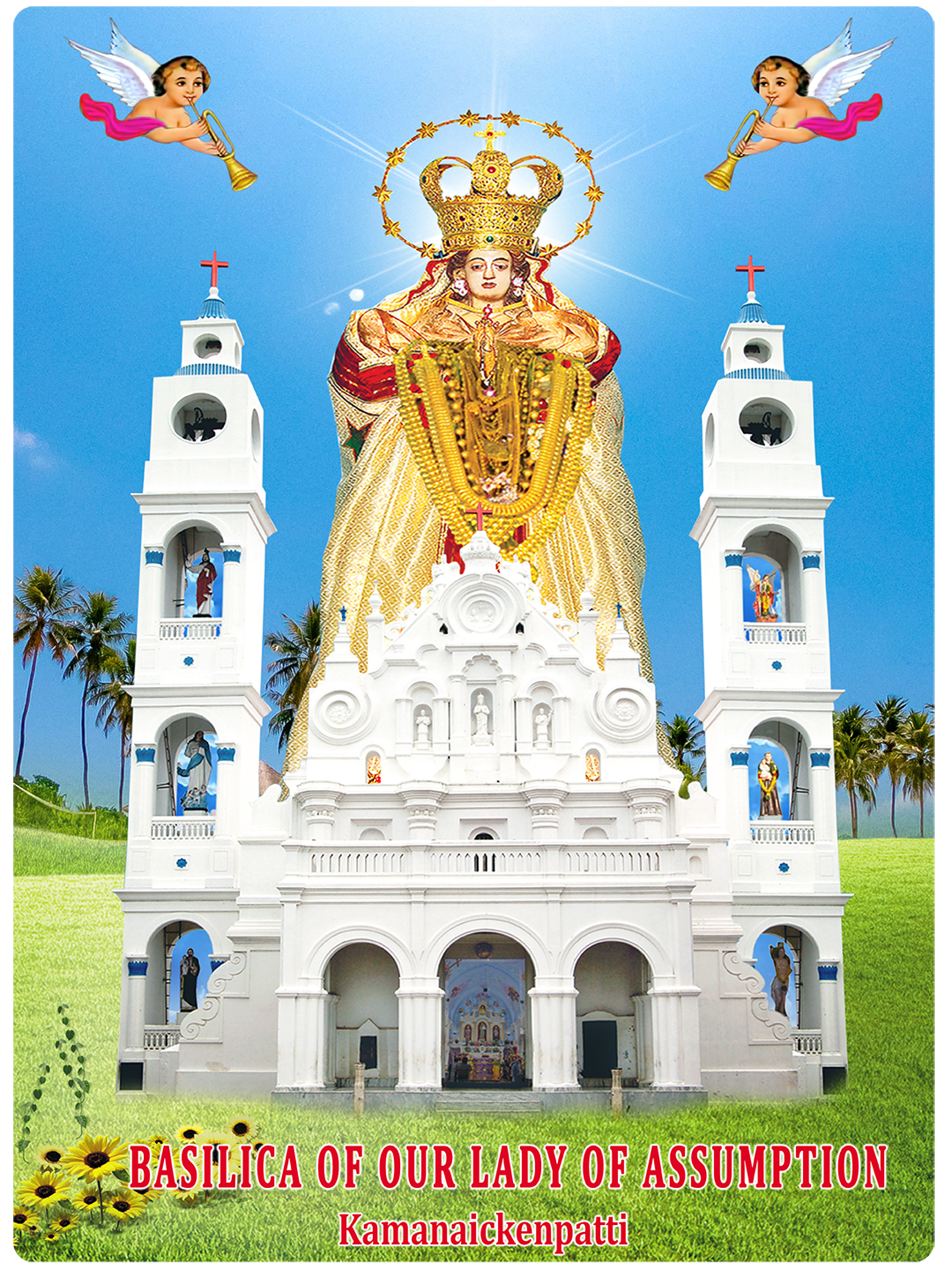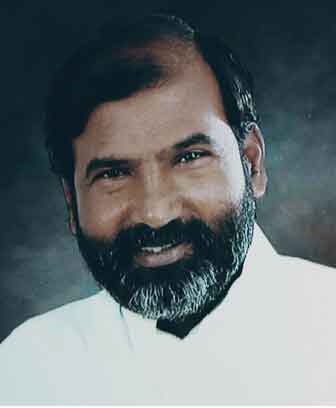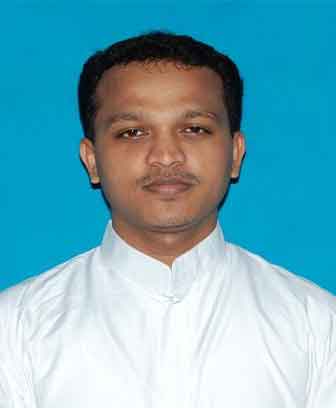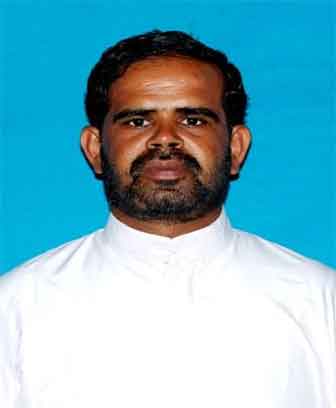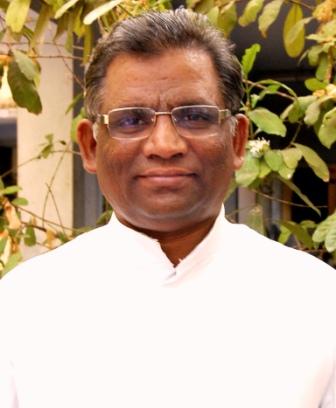History
The Paralogamadha Church is a church in Kamanayakkanpatti in the Diocese of Palayamkottai in Tamil Nadu. It is believed that the Christian community was established in the area by St. Thomas, and the European missionaries found that there were already Christians living here who had a tradition different from the Latin rite. The statue of Our Lady is considered to be miraculous. This church played an important role in the Madurai Mission and is one of the oldest churches in the region. The church was initially built here by St. John de Brito in 1684.[1] One of the earliest reported miracle is from around 1690, when a girl who had fallen into an open well and died was brought back to life through prayers to Mary.[2] The statue survived the destruction of the entire church by fire around 1748.
The feast of the Assumption of Mary is celebrated on 15 August each here with great pomp and fervour. A unique and popular devotion called Kumbidu Sevai is part of the feast day commemoration.
Around 1748 the old Church of
K.N.P. was completely burnt down by some evil forces against the Christian
faith, yet the statue of Our Lady remained unstained and was saved. Though it
was a time of severe famine, the Christians rebuilt it against the thought of
their enemies and with divine providence.
Fr.
Lawrence de Almeyda in charge of Mannargudi or Mannarkoil, falling sick on his
way to the Coast, died at K.N.P, on the first of February 1748 after receiving
the last sacraments. He was known as Rajendra swami, and his tomb can be seen
even today at K.N.P. There was an interval of 82 years from 1756 to 1838.
During this time there were no priests, sacraments, Eucharist etc., yet people
stood firm in their faith by their popular devotion to Our Lady, with the help
of the local catechists. Then Fr. Alexander Martin, known as
Visuvasanandarswami accompanied by Fr. Mousset M.E.P., was the first Jesuit to
visit K.N.P.
Both
celebrated the feast of the Assumption in 1838. Fr. Alexander was firm in
removing the discrimination on the basis of caste and getting settled in the
beginning of the twentieth century. After him Fr. J. Maria Dass extended the
Church and built the present one with much elegance and style. It has a
beautiful sanctuary, altar and stands on twelve pillars signifying the twelve
apostles.
As the
beginning of the jubilee year (325) and an honor to Our Lady, the Rosary Garden
was built with leading of Rev.Fr.Arulambrose (2005-2010) and it is convenient
for people to pray the rosary at all times. It is slowly gaining its lost
importance. This parish is known all over for its significant and unique
devotions to Our Lady called “Kumbidu Sevai”, which tells the emptiness of
human before God. This has got very many cultural impacts among the people and
still holds the faith of the people. This is the first place where the practice
of Car procession was introduced by Fr. Beschi.
Now many
people flock to this place of grace and also experience the hand of God in
their prayers and give thanks to God the Almighty through Our Lady. Last year,
this mission has celebrated 325th jubilee year, many are visiting and honoring
Our Mother. People from all over the country come over here throughout the year
and worship Our Lady.
The Rev. Father Constant Joseph Beschi, known as reverentially Veeramamunivar, who has written the Paramartha Guru Stories and much more Tamil literature including Thembavani, also served as priest in this Parish. There are two big teak wooden cars in the church were built by him. The Church is one of the parishes in RC Diocese, Palayamkottai. The parish includes nearby villages Ettunayakkanpatti, Kuruvinatham and Sevalpatti.
Paralogamadha
The miraculous statue of Paralogamadha at the throne over the main altar of the Church is the specialty here. The faith and love of the villagers for Mother Mary is really amazing. However, their faith and love have their own reason that is the grace and mercy of Mother Mary for the villagers.
Paralogamadha Festival
The feast day recognizing Mary's passage into Heaven is celebrated as the Feast of the Assumption of the Blessed Virgin Mary every year on 15 August here. The feast preceded by hoisting of the flag on 6 August and ends with a Eucharistic Procession around the village on 15 August evening. During these ten days of the Feast, about 2 to 4 lakhs of pilgrims visit the church.
The traditional Car Procession around the village with the miraculous statue of Paralogamadha is the highlight of the Feast. The car procession starts with a special Holy Mass on 14 August midnight and ends with a public procession of the Eucharist on 15 August evening.
Kamanayakkanpatti In The Old Mission
Kamanayakkanpatti played an important part in the former Madurai Mission and might be considered the center of evangelization of the Tirunelveli inland territory at the end of the 17th and 18th centuries.
Whilst Nobili and his companions worked only in the North of Madurai, the South, without being altogether neglected, received few visits from missionaries and the progress of Christianity was consequently slower in that region. Kayathar is first mentioned with a chapel dedicated to St. James, 1644 – 1646. In 166 Fr. Freyre visited twice the South and about the end of the same year Fr. M. Rodiriguez returned to the South, Celebrated Christmas at Tenkasi and Visited Kuttapalayam, Pannikulam, Kamanayakkanpatti and Kayathar. It was the first time that K.N.P. was mentioned. The Christians of Kayathar went there for their confessions. There was the in 1666 a Christian community and a church at Kamanayakkanpatti. Fr. John de Britto (1684 – 1686) visited the South as far probably as Vadakkankulam. For the first time we read the title of the residence of K.N.P. in the annual letter of 1688. “K.N.P. is a small village not far from the Fishery Coast. One of its inhabitants, a Christian of long standing, built a house large enough and suitable enough to lodge the Fathers who would visit them from Madurai. The village seemed to Fr. John de Britto a fit place to administer the sacraments to the faithful and that is why he built there a new church in 1685.
Fr. Xavier Borghese left the village and church of Kayathar where he resided and settled at K.N.P. hoping that the Lord of the place cause of our holy religion.
Fr. Bernard de Saa, a companion of Fr. Borghese was posted at Vadakkankulam and from there he laid the foundation of the Church of Noman in Travancore. During a persecution he was exiled and sent to K.N.P. where Fr. Martin vilsited him in June 1700. While Fr. Borghese himself had been imprisoned for 40 days in Tirunelveli, Fr. Bouchet pleaded with queen Mangammal and managed to set him free and sent him to Vadakkankulam in 1700. In 1708 Fr. Bernard de Saa was still in K.N.P. whence he administered Uthamapalaym.
At the beginning of 1711 Fr. Louis Noel de Bourzes (a French man called by the Portuguses Louis Natal) took charge of K.N.P. and Vadakkankulam till September. Some time after resuming charge, he received Fr. Constant Beschi who had arrived on the 8th May 1711 and put him in charge of Kurukkalpatti about 11 leagues (33 miles) West of K.N.P.
The annual letter of 1712 was written by Fr. Louis Natal – “This residence of K.N.P. entrusted to me, a field assuredly worth of a better labourer, counts seven churches. The difficulty consisted in a staying the time required in each village. The multifarious affairs of the Mission, the necessity of getting from the Coast all the necessary things obliged me to spend in K.N.P. several tedious months. The church is too big for the people who frequent it; it is a safe place but not very agreeable to the missionary and not very suitable for the Christians. It was formerly, more or less, the only church in the country; Christians flocked to it from the farthest villages. Now that churches have been multiplied, we could rightly exclaim “the Roads of Sion mourn because there are none that come to the appointed feasts,” (Lam I, 4.), which means that Christians heeding only to their convenience and not that of the Father becoming lazy owing to the proximity of other churches do not come to this one.” Another church, equal if not superior to this one is that of Kurukkalpatti to the west. It is much more suitable for the administration of Christian but not at all the safest.
In 1713 Vadakkankulam was detached from K.N.P. and again entrusted to Fr. Bernard de Saa. In December 1713 Fr.Louis Natal was recalled to the North and was replaced by Fr. Joseph Vieyra, a new comer into the Mission. Fr. Joseph Vieryre remained but a short time, went to Madurai in the month of August, 1714 and was replaced by Fr. Constant Beschi. On 28th October 1714 on the feast of SS. Simon and Jude, Fr. Beschi made his profession before Fr. Broglia Brrandolini, missionary at Vadakkankulam. Fr. Beschi went to Kurukkalpatti for the feast of Christmas and was made a prisoner by the Maduraian arymy and taken to their camp. There followed a persecution at Tenkasi and then Kayathar. During 1715 Fr. Beschi availing himself of the leisure caused by the persecution, undertook the study of Tamil poetry. In the beginning of 1716 we find at K.N.P. Fr. Broglia Brandolini who had left Vadakkankulam and replaced Fr. Beschi. In 1717 Fr. Brandolini restored the church of Sakkakadi built by Fr. Borghese.
There are no details for the following 10 years. Fr. Brendolini was sent to Europe as procurator of the Mission to deal in particular with the question of the Malabarrites; his successor is not known.
In 1727 Fr. Alexis Pinto was at K.N.P. and Fr. Prosper Giulilani wrote the annual letter 16 July 1728 from Kurukkalpatti. From May to October 1728, Fr. Prosper Giuliani was in charge of K.N.P., and from October Fr. John Baptist Bigaglia.
In 1728 the Church was several times visited by thieves. It was a time of famine, while thieves plundered the village and the church a Christian who was in the church on that night (a thief himself) was seizing the image of the Holy Virgin and was about to carry it away, when all on a sudden, he became blind; seized with right, he shouted in vain for help. Finally he managed to climb over a wall and vanish in the dark.
In 1730 Fr. Bigaglia zealously administered the residence of K.N.P. but most the year he spent in Kurukkalpatti. The church of K.N.P. so often plundered in the past, now that the thief (the rajah of Ettayapuram) was dead, recovered it anquillity, but the country having been deserted by most of its inhabitants, this place did not appear a good choice for the missionary’s residence.
The annual letter of 1731 written by Fr. Beschi tells us that the church had been rebuilt and was dedicated to Paralogamadha.
Fr. Bigalia gave in 1732, 88 adult and 131 children babtisms.
In 1733, 90 and 285; in 1734, 129 and 341; in 1735, 131 and 236.
Though he did all this, residing at Kurukkalpatti, he had to hide to avid arrest as in 1935 there was a war between Minachi and a Lord of the country.
In 1736 Fr. Bigalia was appointed superior of the Madurai Mission and went to Kalpalayam north of Tiruchirappalli.
Fr. Thomas de Fonseca who took his place left the Mission in 1737 and was replaced by John Aloisius. He was succeeded by Fr. James Hartmann in 1740 and transferred to Madurai at the end of 1743.
In 1743, September, Fr. Leonard Jacques was at K.N.P. Though he had only a poor health, he remained till 1745. In his place, Fr. Salvador dos Reis, the Superior of the Mission took charge of the residence. In 1746 Fr. Joseph Khrening was in K.N.P; to judge the extent of the residence, it is enough to say that this Father built a Church at Seduguvai than near the Fishery Coast and another at Vaniampatti near Rajapalayam 80 miles to the to the Kamanayakkanpatti.
In 1748 the church of K.N.P. was completely burnt down by accident. Though ruined by war and famine, the Christians rebuilt it. Fr. Khrening falling sick went to the Fisherey Coast and was replaced by Fr. Manoel Ferraz.
Fr. Lwarence de Almeyda in charge of Mannargudi or Mannarcoil, falling sick on his way to the Coast, died at K.N.P. on the first of February 1748 after receiving the last sacraments. He was known as Rajendranaderswami, and his tomb can be seen at K.N.P.
In 1756 Fr. Felix Maria Orti was missionary at K.N.P. fro the casted people in the South. He baptized 143 adults and 244 children.
The missionary for the low castes was Fr. John Pilip Prati at Tirunelveli, Ninety seven adults and three hundred and thirty one children were baptized by him.
With this all the documentation concerning K.N.P. in the Old Mission ends.
Kamanayakkanpatti In The New Madurai Mission
There was an interval of 82 years from 1756 to 1838. Then Fr. Alexander Martin, known as Visuvasanandarswami accompanied by Fr. Mousset M.E.P., was the first Jesuit to visit K.N.P. Both celebrated the feast of the Assumption in 1838. Fr. Martin returned to the coast and Fr. Louis du Ranuedt remained at K.N.P. from 1839 to 1843. In 1845 Fr. Seles made some conversions there.
From 1850 to 1884 there had been 10 Missionaries administering the parish of K.N.P.
In 1878 a large portion of the parish was given to Fr. Ignacy to form the new parish of Sendamaram. Again from 1884 to 1913 there have been nine missionaries the last mentioned being Fr. J. Mariadas.
In 1878 the parish included the whole territory extending on both sides of the Railway Line from Sattur to Kadambur, Srivilliputtur, and kalugumalai to the right and K.N.P. to the left. In 1879 Srivilliputtur was given to Fr. Trincal. In 1906 Kalugumalai became a separate parish and the parish of K.N.P. was confined within the present (i.e.,1912) limits, east of the Railway line 25 miles North to South and ten Miles from East to West.
Kamanayakkanpatti has a very ancient church dedicated to the Assumption of Our Lady. It is said to date back to 1685. As a matter of fact, in that year St. John de Britto built a church there. But it was not a ‘pucca’ building but a church covered with palmyrah leaves, the kind which could be built in a few days and could be destroyed within the same short space of time. Neither, time nor money allowed the missionary to build a solid construction. In 1729 it was destroyed as well as the whole village and rebuilt in 1731. in 1748 it was accidentally burnt down. Humanly speaking there was no hope to see it rise again from its ruins as the Christians were impoverished by was and famine. However they set themselves to baking bricks and fetched timber from a place two days distant and volunteering to work. They built a much finer church than the one burnt down. This is the present church, long, narrow and vaulted in the style of the period, thrice too small for the gathering of to-day Christians on Sundays. This church was frequented by the Christians of the village, 969 Nadars and 132 Adi-Dravidas and by those of the neighbouring villages. Ettunayakanpatti had 384 Nadar Christians; Sevalpatti 169 Kruvinatham 244, Achankulam 85; Therkku Theethampatti 154, salnayakkanpatti 22 Pallers, Naduvaipatti 20 Adi-Dravidas and 27 Paravars. There was a big rivalry and strife between the Nadars and Vellalars of Kuruvinatham. About the end of the year 1863 at the time of Fr. Giuge, the Vellalars stopped coming to K.N.P. church and built a chapel to St. Michael. It was attended by the Vellalars of the surrounding villages Kuruvinatham with 86 Christians, Ilandaipatti 15, Koppampatti 28, Therkku Sevalpatti 15, Merku Theethampaati 7, Achankulam 15, Sotampatti 7, Therkku Theethampatti 13 and Booinayakkanur 18.
In 1863 the Vellalars and Nadars had come to an agreement by which the latte had to pay an amount of money to the former. This settlement was a thorn in the aide of all the successors of Fr. Guige until 1908 when the tribunal put an end to their dispute. Provided with that sum of money, the Vellalars began the building of a large Gothic Church but for want of funds it was left in complete.
K.N.P. has now a recognised boy’s school attended by 120 Pupils. The Viagulamada convent opened in 1911 had 4 sisters and 73 little girls attending school.
What precedes is taken from Fr. Besse’s book written in 1913. What follows is written from the K.N.P. parish – priest, in 1970. The boys’ school has 240 pupils in eight standards. The girls’ should have four sisters and 113 pupils. From 1666 to 1756 in the old Mission there have been 19 parish Priests; from 1838 to 1969 32, making a total of 51. Out of these there have been only 9 diocesan priests. Fr. J. Mariadas succeeded Fr. Saminathan and worked here from 1903 to 1918. As soon as he entered the arena he had to face the problem of the “Palanquin”. K.N.P. people were opposing the other village people concerning the use of the Palanquin during marriages, while the Father and the others were for it. Troubles and quarrels ensued and so both went to court and the Collector decided that no Palanquin should be used in K.N.P. But the Father was bent upon having it and by some device had the Palanquin brought into K.N.P. with of course, the consent of the dissenters.
No sooner was this dispute over than a more violent one arose concerning the ownership of the parish church in K.N.P. some maintained that the church was their own and the Father maintained both went to court and Fr. Mariadas, a well versed and an experienced missionary won the case. So before 1907 all disputes were over and the Father had a peaceful regime till 1918.
The opponents of Fr. A. Mariadas did not wait long to receive their punishment. As they were joining the Black-Shirt movement on 27th February, scarcely four months after, Pushpam the younger brother of Devasagayam died on cholera without extreme unction. Soon after another one died in the same house. Then on the 28th one more, Sundumuthu Ignaci died of cholera and a fourth one also followed. These four leaders were the first victims of cholera, but 26 more died of it in the following days. But the climax came when the corpse of Pushpam was put in the grave, and a big stone cross rolling down fell on his head and crushed it. A scene that instilled fear in all those who were present.
As the church was too small for the congregation he began a new church while the first Great War had begun in Europe. Though he was advised to stop building, relying on Our Lady, he went on with the work and completed the church. For want of funds he could not build the altar nor plaster the church. Leaving this to be done by his successors, he left the parish in 1918 being still remembered for the existence of the church he had built.
Rev. Fr. Adaikalam succeeded him in 1918 and managed the parish till 1921. He put the second floor of the Presbytery and used planks for the terrace which look as fresh to-day as they were in 1920 when they were first put up; he finally polished and gilded the altar that had been left unfinished by Fr. Mariadas.
Then came Fr. Mas in 1922 who remained for 16 years. It was during his period in 1923 that the Tuticorin diocese was formed with Mgr Roche as its bishop. K.N.P. had to give over to the new diocese Velampatti, Bomayapuram, Pasuvanthanai, Keela Iral, Mudiman and other villages lying with in its limits.
To Father Mas we owe the clearing and deepening of the 5 wells belonging to the church. He commented the floor of the church and plastered all the pillars.
Nadakulam a bone of contention between the Parish priest and the Panchayat Board, had the good fortune of being registered in the name of Sarveswarankoil because of the work of Fr. Mas in and around it and because of his clear and definite entries made in the journal about the expenses incurred on that score. Because of him the case that had been decided against us by the Assistant Settlement Officer was finally settled in our favour by the Director of Settlements, Madras.
Fr. J. Kuruvilla worked from 1941 to 1946. To him is ascribed to the plastering of the outside of the church left undone by Fr. Mariadas.
Then came Fr. A. Mariadas in 1947 who remained there till 1954. He had many and varied incidents (all recorded in his diary) too numerous to be recorded here; but to mention only two events; one is the construction of a ‘pucca’ building for the higher elementary school and the other is the Theethampatti case.
When the Father began the school building that man began to sink a well for the Nadars just to divert the contribution of the people to the School building, this did not prevent the Father from finishing the work he had begun.
Again, just when the Father, in order to safeguard and protect the tamarind trees, began to put up a compound wall round Nandavanam, that man gathered his satellites to oppose the work. As some good people sided with the Father both had to go to court. The collector decided that the man had no reason to interfere with the mud wall enclosure. The Therkku Theethampatti case on which the Father spent his time energy and money is also worth mentioning. On receiving a wire from his advocates; “Success in case”, the Father wrote on 24th November 1950s “Deo graties” God has favoured me. On that joyous day, I must note here an important factor in the history of the case. When one is far out of the particular circumstances, made more vague by long space of intervening time, one cannot understand the purport of all the actions in the case. To begin with, what horrid blood shed would have occurred had it not been for the honourabel course of following the law; how many occasions that cost one life and twenty thousand rupees in 1908? Yes only, those who were on the spot could understand this well. How many nights I had spent sleepless and in horrid and obsessing anxiety that shook me even to the very marrow of my bones, how many cries of anxiety escaped me in those days. Only one who has suffered, has and will have a vivid memory of these things – all these sufferings with the only intention to avert blood shed and murder. Thank God, it was averted.
Though the whole regime of Fr. A. Mariadas was “Cruz at martyrium”, caused by the same man, he never swerved from duty nor was he swayed by any man, but stood firm and loyal to his calling till the end. It was in his time that Kovilpatti was made a separate parish on the 3rd September 1953 and Venkatachalapuram ws attached to it. Similarly Lingampatti was detached from K.N.P.
Fr. Manala during a short time of one year 1957 – 1958, assisted by an able assistant Fr. S. Jesudas, did the splendid work of flooring the sanctuary with the flower tiles and gave it a fine and decorous appearance which really inspires devotion.
18-09-1949, Sunday was a very remarkable day. It was the day fixed for Adoration, as it had been announced on the previous Sunday. The Church was beautifully decorated. The whole of the 17th had passed in decorating the church and the altars. Sunday morning came; all the Christians were crowding around the confessional before Mass. When the first bell had been rung, seven or eight bandies well yoked with bells came and stood in front of the church in the street, all in a line. The second bell went and another group of bandies came and joined those standing in line in front of the church. With the third bell some more bandies came to join the line and now about 23 bandies were standing in a line. On Sunday to go for a picnic trip, while the church bell was calling people fro Mass; for them it was a signal of their own. At the last signal of the bell, the entire congregation walked out shouting and singing. The good people coming to Mass were horror stricken and murmuring while the poor priest was left standing by helpless. What could he do? Not only did the people openly defy the Sunday observance but were using the very bells calling them to Mass as signals for them to march to out for a picnic trip.
That day of Adoration was a day of tears. At 5 p.m. as the priest was giving the blessing with the monstrance, rowdies grouped together in the coffee hotel at the far eastern end of the church street and there, one of them picked up a puppy – an ugly dog, and with that gave a blessing to the group – “All of you fall down and adore”, he said, “I am giving benediction”.
Heavens forbid such thing to be repeated. Finally on 2-2-1964, Vandanam was made a separate parish and Achankulam and Therku Theethampatti were attached to it. Now the actual parish of K.N.P., has only Ettunayakkanpatti, Kuruvinatham, Sevalpatti, Salnayakkapatti, Irachi, Kasavankundu and Duraiyur with a Catholic population of about 3000 souls and God’s grace to keep them faithful to their Christian Vocation.
Fr. P.S. Antonisamy.
Then follows the list of the 52 Parish Priests of K.N.P.
In The Old Mission
- Fr. Freyre - 1666
- Fr. M. Rodriguez - 1667
- Fr. John de Britto - 1684
- Fr. Xavier Borghese - 1685 – 1700
- Fr. Bernard de Saa - 1700 – 1710
- Fr. Louis Natal - 1711 – 1713
- Fr. Constans Beschi - 1713 – 1715
- Fr. Broglia A. Brandolini - 1716
- Fr. Alexis Pinto - 1727 – 1728
- Fr. Prosper Giulani - 1728 May – Oct
- Fr. J.B. Bigaglia - 1728 – 1735
- Fr. John de Fonseca - 1735 – 1737
- Fr. John Aloisius - 1737 – 1740
- Fr. James Hartmann - 1740 – 1743
- Fr. Leonard Jacque - 1743 – 1745
- Fr. Salador dos reis - 1745
- Fr. Joseph Khrening - 1746 – 1748
- Fr. Manuel Ferraz - 1748 – 1756
- Fr. Felix Maria Orti - 1756
In The New Mission
- Fr. Alexander Martin - 1838 – 1839
- Fr. Louis du Ranquet - 1839 – 1843
- Fr. Antony Sales - 1843 – 1845
- Fr. Benjamin Cauneille - 1850 – 1851
- Fr. Julius Billas
- Fr. Tomas Giuge - 1852 – 1855
- Fr. Ernest Rigot - 1855 – 1858
- Fr. Tomas Giuge - 1859 – 1864
- Fr. Henry Elorza - 1864
- Fr. Francis Buisson - 1865 – 1867
- Fr. Victor Besset - 1867 – 1875
- Fr. Julius Larmey - 1875 – 1876
- Fr. C. Dariam - 1876 – 1884
- Fr. Adrian Bouisset - 1884 – 1893
- Fr. Justin Baumal - 1893 – 1895
- Fr. Stephen Talon - 1895 – 1899
- Fr. Ernest Rigot - 1899 – 1901
- Fr. L. Paranjothi - 1901 – 1902
- Fr. Stephen Talon - 1902 – 1903
- Fr. Saminathan -
- Fr. J. Mariadas - 1903 – 1918
- Fr. Adaikalam - 1918 – 1921
- Fr. A. Martin - 1921 – 1922
- Fr. Maa - 1922 – 1938
- Fr. Thomas Fernando - 1938 – 1941
- Fr. J. Kuruvilla - 1941 – 1946
- Fr. J. Ross - 1946 – 1947
- Fr. A. Mariadas - 1947 – 1954
- Fr. K.S. Visuvasam - 1954 – 1957
- Fr. J. Mannala - 1957 – 1958
- Fr. E.M Culas - 1958 – 1964
- Fr. P.S. Antonisamy - 1964 – 1973
- Fr. S. Arokiasamy - 1973 – 1976
- Fr. Lordu Raj - 1976 – 1978
- Fr. S. Joachim - 1978 – 1981
- Fr. M. Berchamans - 1981 – 1983
- Fr. S. Alphonse - 1983 – 1985
- Fr. N. James Nicholas - 1985 – 1989
- Fr. S. Annasamy - 1989 – 1994
- Fr. Joachim - 1994 – 1996
- Fr. Rasaiya - 1996 – 2000
- Fr. Rex Justin - 2000 – 2005
- Fr. Arul Ambrose - 2005 - 2010
- Fr. S.A Antony Samy - 2010
